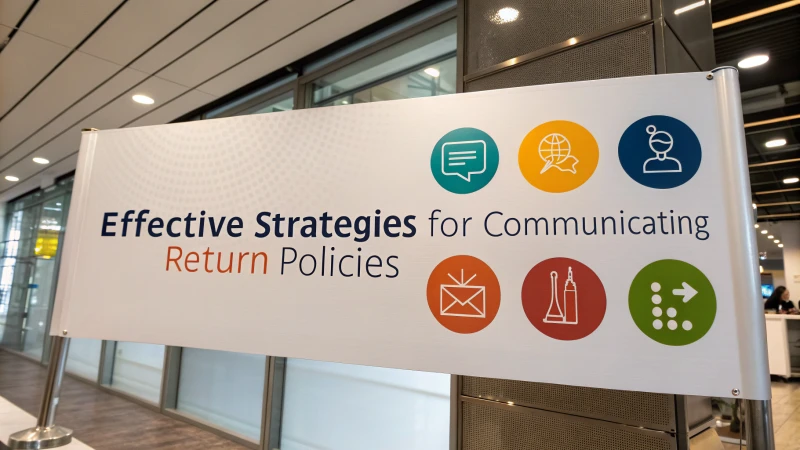
Navigating return policies for custom orders can be tricky, but it's essential for keeping your business running smoothly and your customers happy.
To manage return policies for custom orders effectively, I recommend establishing clear guidelines that state these items are non-returnable unless there are manufacturing defects. Providing limited adjustments can enhance customer satisfaction while maintaining open communication to prevent misunderstandings.
Reflecting on my journey, I recall how crafting a return policy felt daunting at first. My first few custom orders taught me the importance of clarity. Sharing these insights, I realized that specific strategies—like offering a small window for fit adjustments—helped bridge gaps between customer expectations and what I could feasibly offer. By maintaining transparency and staying open to dialogue, I found that I could reduce returns while nurturing trust and satisfaction. Let's dive into some practical tips I've picked up along the way.
Custom orders are always non-returnable.False
Custom orders can be returned if there are manufacturing defects.
Open communication reduces return misunderstandings.True
Maintaining clear communication helps clarify policies and expectations.
How Can You Craft a Successful Custom Order Return Policy?
Creating a custom order return policy is like crafting a heartfelt letter to your customers, balancing honesty with their needs.
A successful custom order return policy requires clear communication about return conditions, reasonable timelines, and customer-focused solutions for any defects. It should be transparent and easy for customers to find and understand.

Understanding the Importance of Clarity
When I first started dealing with custom orders, I quickly realized that clarity in my return policy1 was crucial. Imagine receiving a beautifully tailored item only to find it's not quite right, and then discovering a labyrinth of unclear return rules. Frustrating, right? So, outlining which items are eligible for returns is essential. For example, custom-made products often can't be returned unless there's a manufacturing defect. Clearly stating this upfront can help manage expectations and prevent misunderstandings.
Defining Return Exceptions
Early on, I learned the value of defining specific conditions under which returns are accepted. Consider this: a customer receives a product that doesn't match the agreed specifications—this is where returns or exchanges should be possible. I've found using a simple table can make these conditions clearer:
| Condition | Return Eligibility |
|---|---|
| Manufacturing Defect | Eligible |
| Incorrect Customization | Eligible |
| Customer Change of Mind | Not Eligible |
Setting Reasonable Timelines
Timelines are like the unsung heroes of return policies. Establishing a specific window for initiating returns—say, 30 days from receipt—keeps both my business and customers on the same page. It's like agreeing on a fair handshake deal.
Ensuring Easy Accessibility
I remember the relief of finding an easy-to-read policy when I was in a bind with a return. That's why I make sure my return policy is easily accessible, perhaps through a dedicated page on my website or included in confirmation emails. This transparency can significantly enhance trust.
Providing Customer-Centric Solutions
Handling issues like manufacturing defects2 calls for customer-centric solutions. Offering free alterations or exchanges isn't just about fixing an error—it's about building goodwill. Quickly and efficiently resolving these issues shows customers they're valued, turning a potential setback into an opportunity to strengthen our relationship.
Using markdown tables has helped me clearly lay out these points, and adding pseudo-links guides my customers to more detailed information when needed. These practices not only streamline the process but also convey a sense of care and professionalism.
Custom-made products are always returnable.False
Custom-made products are generally non-returnable unless defective.
Return policies should be easily accessible to customers.True
Accessibility enhances transparency and trust in return policies.
How Can You Communicate Return Policies Clearly to Customers?
Ever found yourself tangled in a confusing return policy? We've all been there, and it's not fun. Simplifying this process for your customers can make a world of difference.
To communicate return policies clearly, I use simple language, offer multiple ways to access the information, and prominently highlight key terms. This approach ensures transparency and builds customer trust.

Use Simple and Direct Language
I remember the frustration of trying to decipher a return policy that seemed written in another language. That's why when I craft my own, I steer clear of jargon and legalese. My rule of thumb? Keep it simple. Instead of saying "Items must be returned in resalable condition," I say "Items must be unworn, unwashed, and with all original tags attached." This way, there's no guessing what I mean.
Provide Multiple Access Points
Ever struggled to find the return policy when you needed it most? To spare my customers that hassle, I make sure the policy is visible everywhere—on the website footer, during checkout, and in every confirmation email. This way, no matter where they are, they can easily find what they need.
Highlight Key Terms and Conditions
I like to think of this as adding a little neon sign to the important bits. Using bold text or bullet points helps draw attention to crucial details. For example, if custom products can't be returned, I make sure that's clearly stated upfront. Here's how I lay it out:
| Key Points | Details |
|---|---|
| Return Window | 30 days from purchase date |
| Non-returnable Items | Custom products |
| Return Conditions | Items must be unworn and unwashed |
Consistency Across Platforms
Imagine being told one thing online and another in-store—confusing, right? That's why I ensure consistency across all platforms, whether it's on my website, social media, or printed materials. Keeping the message the same everywhere helps prevent confusion and builds trust. Ensuring consistency3 is essential for maintaining a unified brand message.
Leverage Customer Service Interactions
I can't overstate the power of good customer service. I train my team to understand our return policy inside out so they can answer questions and clear up any doubts quickly. Having a script or FAQ section they can refer to makes this process smoother.
By following these strategies, I've found that communicating return policies effectively not only enhances customer trust but also satisfaction. If you're looking for more in-depth guidance, check out customer communication strategies4.
Return policies should use simple language.True
Simple language ensures customers understand return requirements easily.
Custom products are always returnable.False
Custom products are often non-returnable due to personalization.
How Can I Minimize Returns for Custom Products?
I've been on the receiving end of a few too many returned custom products, and let me tell you, it's not fun. But there are ways to cut down on those returns and keep everyone happy.
To minimize returns for custom products, I focus on crafting clear return policies, providing accurate product descriptions, and maintaining open communication with customers. These strategies help prevent misunderstandings and align expectations.

Crafting Clear Return Policies
In my experience, nothing beats a well-thought-out return policy. It’s essential to make it clear that custom products are non-returnable unless there’s a defect. This policy should be easy to find and impossible to miss during the checkout process5. I once had a customer miss this detail, and it led to an awkward conversation—lesson learned!
Accurate Product Descriptions
I always ensure my product descriptions are as detailed as possible. Providing accurate sizing charts and offering visual aids6 like 3D models or high-resolution images can work wonders. I remember a time when a customer was unhappy with their order because the color looked different in person; since then, I’ve made sure to include detailed images to set the right expectations.
Effective Customer Communication
Keeping the lines open for customer queries has made a huge difference in my business. Offering consultations before purchase helps tailor products to specific needs and reduces dissatisfaction. Once, a simple conversation about fabric choices saved me from a potential return because the customer realized they had picked the wrong material.
Implementing Fit Guarantees
Offering limited adjustments or exchanges can be a game-changer. It boosts confidence and decreases the chances of returns. I started doing this after noticing some customers hesitated to buy due to fit concerns—it’s been a win-win for everyone.
| Strategy | Benefit |
|---|---|
| Clear Return Policies | Sets customer expectations |
| Accurate Descriptions | Reduces misunderstandings |
| Open Communication | Builds trust and addresses concerns |
| Fit Guarantees | Enhances customer satisfaction |
Monitoring and Analyzing Feedback
I make it a point to regularly check customer feedback to spot patterns in returns. This analysis helps me identify common issues and take proactive steps to minimize future returns. It’s amazing what you can learn just by listening!
Utilizing Technology for Precision
I’ve invested in technology like virtual fitting rooms and augmented reality tools to help customers make informed choices, thus minimizing returns. Exploring AI-driven solutions7 has been eye-opening for me, transforming the shopping experience into something truly interactive.
Enhancing Quality Control Processes
Finally, strict quality control ensures that only top-notch products reach customers. Implementing rigorous checks at various production stages has significantly reduced the number of returns due to quality issues. It’s a bit more work upfront, but the payoff is worth it in the long run.
Custom products are always non-returnable.False
Custom products are generally non-returnable unless defective.
Virtual fitting rooms can reduce product returns.True
Virtual fitting rooms help customers make informed choices, reducing returns.
How Do You Handle Defects or Errors in Custom Orders?
Ever wondered how to handle a hiccup in a custom order without losing your cool or your customers?
To effectively manage defects in custom orders, I ensure there's a clear return policy, robust quality checks, and maintain open communication with customers. These steps not only resolve issues swiftly but also build trust.

When I first started dealing with custom orders, I remember how nerve-wracking it was to get that call or email about something not being quite right. But over time, I've learned that handling defects with a clear plan and open heart can turn a potential disaster into an opportunity for strengthening customer relationships.
Establishing a Clear Return Policy
Creating a clear and comprehensive return policy8 is essential. I make sure to clearly state that custom products are non-returnable, except for manufacturing defects or errors. Offering limited options for adjustments or exchanges to improve fit can really help ease any frustrations.
| Policy Element | Description |
|---|---|
| Non-returnable | Custom items are generally non-returnable |
| Defect Exceptions | Returns accepted only for manufacturing defects |
| Adjustment Options | Limited exchanges for fitting improvements |
Implementing Quality Assurance Procedures
In my experience, a solid quality assurance process is like having a safety net. It catches defects early and saves a lot of headaches later. This involves thorough inspections and testing at various stages of production. Tools like statistical process control9 are invaluable in pinpointing potential issues before they reach the customer.
- Inspection Points:
- Pre-production checks
- In-process inspections
- Final product evaluations
Maintaining Open Communication with Customers
Keeping the lines of communication open with customers is crucial. I always try to inform them proactively about any potential delays or defects. Offering solutions like discounts or replacements can really help maintain goodwill. Listening to customer feedback is a goldmine for improving your processes10.
Tips for Communication:
- Keep responses prompt and informative.
- Provide updates on order status regularly.
- Address complaints with empathy and solutions.
Utilizing Agile Methodologies
Adopting agile methodologies11 has been a game-changer for me. It allows for quick adaptations when defects pop up in custom orders. Agile focuses on iterative progress, which is fantastic for addressing and resolving issues promptly.
Custom orders are non-returnable by default.True
Custom products are typically non-returnable unless they have defects.
Agile methodologies hinder defect resolution in custom orders.False
Agile promotes quick adaptation and resolution of defects.
Conclusion
Effectively managing return policies for custom orders involves clear guidelines, open communication, and customer-centric solutions to minimize misunderstandings and enhance satisfaction while addressing defects appropriately.
Exploring these elements can provide insights into best practices for crafting effective policies that align with customer needs. ↩
Learn how to address manufacturing defects effectively to maintain customer satisfaction and ensure quality control in custom orders. ↩
Consistency across platforms ensures customers receive the same message everywhere, enhancing trust. ↩
Explore strategies to improve customer communication and enhance clarity in business policies. ↩
Learn strategies to highlight your return policy effectively during the checkout process, ensuring customer awareness. ↩
Discover how visual aids can enhance customer understanding and satisfaction, reducing return rates. ↩
Explore innovative AI-driven tools that improve customer shopping experiences, leading to fewer returns. ↩
This link provides strategies on crafting effective return policies, ensuring clarity and reducing misunderstandings. ↩
Exploring this link reveals methods for implementing statistical process control, improving quality assurance in custom orders. ↩
Discover techniques to leverage customer feedback for refining processes, enhancing product quality and service. ↩
Learn how agile methodologies can optimize defect management, promoting efficiency and adaptability. ↩






